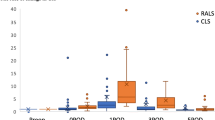Abstract
This study aimed at reviewing a contemporary series of patients who underwent robotic renal and adrenal surgery by a single surgeon at a tertiary referral academic medical center over a 6-year period, specifically focusing on the unique and serious complication of post-operative rhabdomyolysis of the dependent lower extremity. The cases of 315 consecutive patients who underwent robotic upper tract surgery over a 6-year period from August 2008 to June 2014 using a standardized patient positioning were reviewed and analyzed for patient characteristics and surgical variables that may be associated with the development of post-operative rhabdomyolysis. The incidence of post-operative rhabdomyolysis in our series was 3/315 (0.95 %). All three affected patients had undergone robotic nephroureterectomy. Those patients who developed rhabdomyolysis had significantly higher mean Body Mass Index, Charlson Comorbidity Index, and median length of stay than those who did not. The mean OR time in the rhabdomyolysis group was noted to be 52 min longer than the non-rhabdomyolysis group, though this value did not reach statistical significance. Given the trends of increasing obesity in the United States and abroad as well as the continued rise in robotic upper tract urologic surgeries, urologists need to be increasingly vigilant for recognizing the risk factors and early treatment of the unique complication of post-operative rhabdomyolysis.

Similar content being viewed by others
References
Alterman I, Sidi A, Azamfirei L, Copotoiu S, Ezri T (2007) Rhabdomyolysis: another complication after prolonged surgery. J Clin Anesth 19:64–66
Bellomo R, Kellum JA, Ronco C (2012) Acute kidney injury. Lancet 380:756–766
Better OS, Rubinstein I, Winaver JM, Knochel JP (1997) Mannitol therapy revisited (1940-1997). Kidney Int 52:886–894
Bosch X, Poch E, Grau JM (2009) Rhabdomyolysis and acute kidney injury. N Engl J Med 361:62–72
Bywaters EGL, Beall D (1941) Crush Injuries with Impairment of Renal Function. BMJ 1:427–432
Charlson ME, Pompei P, Ales KL, MacKenzie CR (1987) A new method of classifying prognostic comorbidity in longitudinal studies: development and validation. J Chronic Dis 40:373–383
Deane LA, Lee HJ, Box GN, Abraham JB, Abdelshehid CS, Elchico ER, Alipanah R, Borin JF, Johnson RW, Jackson DJ, McDougall EM, Clayman RV (2008) Third place: flank position is associated with higher skin-to-surface interface pressures in men versus women: implications for laparoscopic renal surgery and the risk of rhabdomyolysis. J Endourol 22:1147–1151
DeLong JM, Shapiro O, Moinzadeh A (2010) Comparison of laparoscopic versus robotic assisted partial nephrectomy: one surgeon’s initial experience. Can J Urol 17:5207–5212
Flegal KM, Carroll MD, Kit BK, Ogden CL (2012) Prevalence of obesity and trends in the distribution of body mass index among US adults, 1999-2010. JAMA 307:491–497
Ghani KR, Sukumar S, Sammon JD, Rogers CG, Trinh QD, Menon M (2014) Practice patterns and outcomes of open and minimally invasive partial nephrectomy since the introduction of robotic partial nephrectomy: results from the nationwide inpatient sample. J Urol 191:907–912
Glassman DT, Merriam WG, Trabulsi EJ, Byrne D, Gomella L (2007) Rhabdomyolysis after laparoscopic nephrectomy. JSLS 11:432–437
Goodman SM, Figgie M, Green D, Memtsoudis S (2013) Rhabdomyolysis is a Potential Complication of Total Hip Arthroplasty in the Morbidly Obese. HSS J 9:200–202
Hothorn T, Hornik K, van de Wiel MA, Zeileis A (2008) Implementing a Class of Permutation Tests: the coin Package. J Stat Softw 28:1–21
Kanter R, Caballero B (2012) Global gender disparities in obesity: a review. Adv Nutr 3:491–498
Kuang W, Ng CS, Matin S, Kaouk JH, El-Jack M, Gill IS (2002) Rhabdomyolysis after laparoscopic donor nephrectomy. Urology 60:911
Lagandré S, Arnalsteen L, Vallet B, Robin E, Jany T, Onraed B, Pattou F, Lebuffe G (2006) Predictive factors for rhabdomyolysis after bariatric surgery. Obes Surg 16:1365–1370
Laviana AA, Hu JC (2014) Current controversies and challenges in robotic-assisted, laparoscopic, and open partial nephrectomies. World J Urol 32:591–596
Patel HD, Mullins JK, Pierorazio PM, Jayram G, Cohen JE, Matlaga BR, Allaf ME (2013) Trends in renal surgery: robotic technology is associated with increased use of partial nephrectomy. J Urol 189:1229–1235
Reisiger KE, Landman J, Kibel A, Clayman RV (2005) Laparoscopic renal surgery and the risk of rhabdomyolysis: diagnosis and treatment. Urology 66:29–35
Swinburn BA, Sacks G, Hall KD, McPherson K, Finegood DT, Moodie ML, Gortmaker SL (2011) The global obesity pandemic: shaped by global drivers and local environments. Lancet 378:804–814
Wolf JS, Marcovich R, Gill IS, Sung GT, Kavoussi LR, Clayman RV, McDougall EM, Shalhav A, Dunn MD, Afane JS, Moore RG, Parra RO, Winfield HN, Sosa RE, Chen RN, Moran ME, Nakada SY, Hamilton BD, Albala DM, Koleski F, Das S, Adams JB, Polascik TJ (2000) Survey of neuromuscular injuries to the patient and surgeon during urologic laparoscopic surgery. Urology 55:831–836
Woodrow G, Brownjohn AM, Turney JH (1995) The clinical and biochemical features of acute renal failure due to rhabdomyolysis. Ren Fail 17:467–474
Conflict of interest
Russell Terry, Travis Gerke, James Mason, Matthew Sorensen, Jason Joseph, Philipp Dahm and Li-Ming Su declare that they have no conflict of interest.
Author information
Authors and Affiliations
Corresponding author
Rights and permissions
About this article
Cite this article
Terry, R.S., Gerke, T., Mason, J.B. et al. Postoperative rhabdomyolysis following robotic renal and adrenal surgery: a cautionary tale of compounding risk factors. J Robotic Surg 9, 195–200 (2015). https://doi.org/10.1007/s11701-015-0515-2
Received:
Accepted:
Published:
Issue Date:
DOI: https://doi.org/10.1007/s11701-015-0515-2




